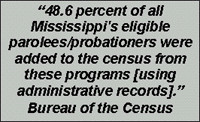
| |    Parole/Probation Files Improved Local Accuracy In 1990, the Bureau successfully used state and local administrative records to locate nearly half a million people in one of the hardest-to-count populations: people on parole and probation. Experience suggests people with a criminal record were highly unlikely to answer a government census-taker in 1990, and are just as unlikely to answer a government survey-taker in Census 2000.

The Parolee/Probationer Coverage Improvement Program (PPCIP) and the Parolee/Probationer Coverage Improvement Follow-up Program (PPCIPFU) were created to locate this hard-to-count population. Since parolees and probationers are required to report any address change, and are unlikely to be found through a census or a survey, the Bureau reasoned this would be an ideal population to locate using administrative records. Combined, the programs added 447,757 persons to the census that would otherwise have gone uncounted – 0.2 percent of the total 1990 population.
Also, disproportionate numbers of parolees and probationers are members of minority populations, particularly African-American males. The Bureau reasoned this approach would reduce the differential undercount.47 The Bureau reported "approximately 27.1 percent of all person adds were Black males." In 1990, African-American men made up only about six percent of the total population. Since the proportion of "adds" was greater than the proportion of population, the Bureau concluded, "these programs did help to address the differential undercount."
|
   |
|

